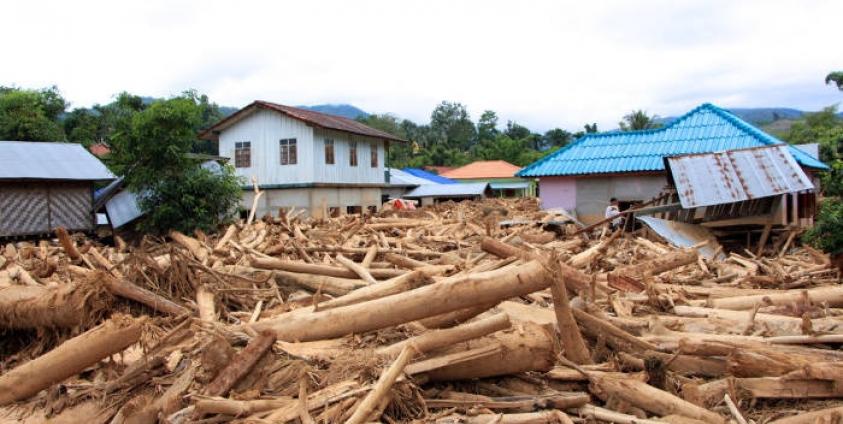Weeks after flash flooding destroyed homes and farmland, villagers in eastern Shan State find themselves struggling to rebuild amidst the debris.
PHOTOS BY SAI MYO OO / Shan Herald Agency for News (S.H.A.N.)
July and August’s uncharacteristically strong monsoon floods affected an estimated one million people throughout Burma, reaching all but two of the country’s fourteen states and destroying more than one million acres of farmland. The government has attributed 100 deaths to the catastrophe. The Irrawaddy reported that more than 330,000 people were displaced in Irrawaddy Division, and disaster zones were declared in Arakan and Chin States and Magwe and Sagaing Divisions.
Eastern and northern regions of Shan State experienced flash flooding earlier this month, resulting in lost lives, infrastructure, homes and farmland. On 18 August Sai Myo Oo, a Shan Herald Agency for News photographer, traveled to Tachileik District in the eastern region of his home state to document the impact of the disaster once the water had receded.
“When the flooding came, it was like an earthquake,” recalled one villager, describing the early morning of 4 August, when the waters of the Nam Paeng river burst its banks in eastern Shan State’s Tachileik District. Nine villages along the river suffered damage, and the residents of the area continue to sift through debris and rely on community-sourced aid as they struggle to rebuild.
Streets remain clogged with debris in the village of Nam Gai. After heavy rainfall on 3 August flooding began in the early morning on the following day. “It wasn’t big at first,” said locals who claim the area had never flooded in the past. But by 4:00 or 5:00 a.m., water rushed in, carrying large stones, sediment, and most notably, logs and uprooted trees. Most locals heeded a warning from the village head and fled their homes before the river rose, but there were still four casualties in the village of Nam Gai: three women and one young boy passed away in the disaster. The water level dropped after only one hour, revealing the extent of the destruction.
PHOTO 2

Photo by S.H.A.N.
After this bridge was washed away by the river on the morning of August 4, a footpath was rebuilt from bamboo by the villagers of Nam Paeng.
PHOTO 3

Photo by S.H.A.N.
Once the waters receded, it was revealed that the rice paddies had been destroyed. Most of the villagers in this region are subsistence farmers. They predict that the loss of this crop will set them back two years. In order to make the paddies fertile again, the farmers must remove the rubble and sediment deposited by the flood.
PHOTO 4

Photo by S.H.A.N.
Stores of rice—a staple food—saved from the previous year’s harvest to feed the village this year have been ruined by the flood. According to traditional Shan methods, farmers harvest their rice crop and consume some of the rice that same year, and store a large amount to eat during the following year.
PHOTO 5

Photo by S.H.A.N.
In the village of Nam Gai, two men pull a television out of the mud. They explained that they had saved their money and bought it for their family two months earlier. “It won’t work anymore,” the photographer told them. “Maybe it will,” one man responded. “And if not, we can just display it in our house anyway, for show.”
PHOTO 6

Photo by S.H.A.N.
Loong Noom, 46 years old, divided his time between Nam Paeng village, where he had built a home for his aging parents, and Tachileik, where his business selling onions is based. Here, he points to the area where his two-year-old custom-designed house stood before being washed away by the river after which the village is named. His parents survived, but his father was caught in the floodwaters, clinging to a floating log until he was rescued by villagers. “I’m lucky that my father is still alive now,” Loong Noom said.
PHOTO 7

Photo by S.H.A.N.
This is the last remaining photo of the house Loong Noom built for his elderly parents, which completely washed away in the flash flood on August 4. He had bought the land years before, and carefully saved for the house’s construction. “I have to save money again,” he said. “I have to think about where my parents will live.” He reflected that it may be too difficult to build such a structure again.
PHOTO 8

Photo by S.H.A.N.
Outside the temple in Nam Gai, aid is distributed. Each of the packs includes cooking and eating utensils, dry noodles, salt, oil, blankets and sleeping mats. Funds for the flood victims were collected by local monks, political parties, and Shan associations and communities in Thailand and Burma. The government donated rice and offered free first aid services from visiting nurses from Tachileik.
PHOTO 9

Photo by S.H.A.N.
Stilts were not able to save this traditional wood-and-bamboo house from the floodwaters. More than 160 houses were damaged or lost in the district, as well as two schools. Two hundred residents are now staying in the local temple or with relatives. Many are surviving on donations. Electricity has not returned to the villages.
PHOTO 10

Photo by S.H.A.N.
Residents survey the farmland in Nam Gai. They are determined to stay and rebuild, but still require special equipment to remove large logs deposited by the river. It has been suggested that companies mining for gold in the area could lend bulldozers to assist with the cleanup, but no such arrangement has been made yet. Locals also speculate that the severity of August’s flood could be related to the mining industry’s practice of deforestation, which is linked to increased soil erosion and higher water runoff speeds.







